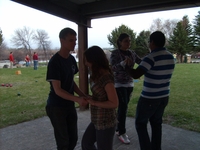
Rumba
 Birthplace: Cuba
Birthplace: Cuba
Creation date: early 1900s
Creators: Rural Cubans
Dance type: American Rhythm
The Rumba is often referred to as the dance of love. It tells a story of flirtation and courtship. The roots of the Rumba go back to African ceremonial dances. Africans who were forced into slavery by the Spanish colonists brought these dances with them to Cuba nearly two hundred years ago. These dances were then combined with Cuban folk dances and evolved into the Rumba.
It took three attempts for the Rumba to catch on in the United States. The first attempt was in 1913 in New York and went nowhere. The second attempt ten years later featured imported Rumba musicians and two Rumba dancers, but again Americans weren't interested. Finally, in the 1930s, a new orchestra specializing in Latin music was formed in Los Angeles. This new style of music and dance was featured in two motion pictures, one titled "The Rumba." After this broad introduction, it was fully embraced by the dancing public.
What became popular as the "American Rumba" was a slower version of the original Cuban Rumba. The original dance was described as being fast and frantic. For a time it was banned in Cuba as being too wild to dance in public. American dance teachers changed the diamond pattern to a box pattern because their students were already familiar with the foxtrot box step. They added subtle hip movements to give it a Latin feel. The box step remains a basic pattern of the American style Rumba. The "Cuban Rumba" is now danced as the international style Rumba and retains the original diamond pattern.
This work is credited to BYU-Idaho dance book 2006.
Call Kevin Hunter 208-870-6737 EMail: captindanceman@yahoo.com















